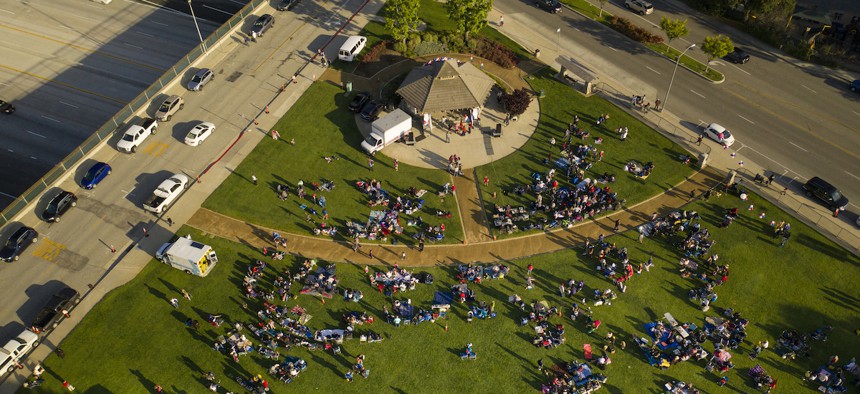Drones enlisted for real-time monitoring of public events

Spiderplay/Getty Images
As Illinois residents enjoy outdoor summer events, a new law allows public safety agencies to use drones to protect the public from potential threats.
As summer ramps up, the season’s late sunsets and warm weather draw communities to outdoor events like festivals and sports games. These large gatherings, however, may also attract bad actors.
Take last year’s mass shooting during a Fourth of July parade in Highland Park, Illinois. Hundreds of community members celebrated amid festive red, white and blue decorations, but just 15 minutes after the parade started, a sniper on a nearby rooftop opened fire on the crowd. Seven individuals were killed, and nearly 50 more were injured.
One Illinois lawmaker, Sen. Julie Morrison, was in the crowd that day and has since championed legislation to allow public safety agencies to monitor certain public events using drones. On June 16, the Drones as First Responders Act was signed into law, and it allows law enforcement agencies to use drones for real-time monitoring and threat detection during outdoor events, officials announced earlier this month.
Under the act, drones can only be used at events that are outdoors, open to the public and hosted by the state, a county, a municipality, a township or a park district. It also allows drones to be used for infrastructure inspections, public relations events such as taking a photo of a local organization and to assist with public safety response, such as locating victims or fleeing suspects.
“Unfortunately, it was a bad situation that helped push this change for the better,” said Lt. Matt Udelhoven of the Elgin Police Department in Illinois. But the law shows how technology can improve public safety.
For instance, agencies can now conduct spot checks on public events with drones. That means, authorities may choose to fly a drone over an event space at timed intervals, such as every 30 or 60 minutes, to proactively monitor activity, Udelhoven said. Since drones have a limited battery life, event attendees don’t have to worry about constant drone surveillance, he added.
Drones can also survey the venue’s surrounding area to spot suspicious activity prior to the event’s start or monitor entry and exit points so public safety personnel can better execute an emergency response.
Illinois’ approach to drones highlights how public safety agencies are still learning to leverage drones. Maybe 10% or less of law enforcement agencies are using drones for real-time monitoring of mass gatherings, said Jonathan Beal, president of the Law Enforcement Drone Association, a nonprofit organization dedicated to drone implementation in the public safety sector.
The new act builds upon previous legislation, the Freedom from Drone Surveillance Act of 2014, which already allowed drones to be used for criminal investigations, traffic crash or crime scene photography, disaster response or counterterrorism efforts. Prior to the change in the law, public safety agents could be on the scene with a drone but would have to wait for a 9-1-1 call to come through reporting a committed crime or a missing person, for example, to deploy it, Udelhoven said. Now, agencies can leverage drones in a proactive manner.
There are plenty of other situations where drones can “potentially mitigate risk to the public and the officers at large,” Beal said. “This is a commonsense adjustment to … the Freedom from Drone Surveillance Act.”
The updated law can also help agencies shorten response times and lighten the burden on personnel at the scene. It’s unlikely a city has enough staff to monitor every part of an event, Udelhoven said. For instance, if an individual were to drive into a crowd of parade goers, a drone could scan the area in a matter of minutes—or even seconds—and provide an aerial view of where the vehicle was headed.
“It’s a totally different view from standing at the ground level to having that aerial advantage, 100 or 200 feet up in the sky. You can see much more,” Udelhoven said. Then, drone operators could instantly communicate that information to officers in the field via radio or livestreaming for a timely response.
To ensure residents’ safety and privacy, agencies are prohibited from using drones with facial recognition software or those with weapons such as lasers, projectiles or chemical irritants. However, it is unlikely drones used at the local and state level even have those capabilities, Udelhoven said.
Still, public safety agencies push for new technologies to improve response and protect residents.
At one time, “people were afraid of moving police from revolvers to disposable magazines,” Beal said. “People change, technology changes, the criminal element changes, and we have to adapt.”






